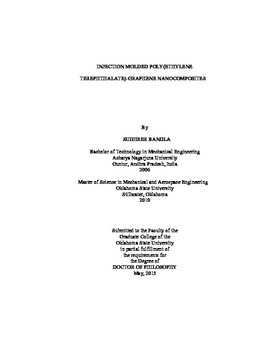| dc.contributor.advisor | Hanan, Jay C. | |
| dc.contributor.author | Bandla, Sudheer | |
| dc.date.accessioned | 2018-04-23T19:36:16Z | |
| dc.date.available | 2018-04-23T19:36:16Z | |
| dc.date.issued | 2015-05 | |
| dc.identifier.uri | https://hdl.handle.net/11244/299548 | |
| dc.description.abstract | Polymer nanocomposites are known for their superior properties (mechanical, thermal, etc.) compared to conventional composites. Nanoscale reinforcements are used to make such composites as they have fewer defects and higher aspect ratios. Achieving uniform dispersion of nanoparticles in a polymer matrix is fundamental in realizing their advantage as reinforcements. Poly(ethylene terephthalate) (PET) is an aromatic polyester, commonly used in textile, packaging and engineering applications. Improving the properties of PET through addition of nanoreinforcements can enable new applications. This study investigates the processing and performance of PET-graphene nanocomposites. | |
| dc.description.abstract | Graphene is a relatively new nanomaterial with a unique combination of properties. Because of their higher effective surface area and favorable aromatic-aromatic interactions, graphene is a suitable reinforcement to improve mechanical properties of PET. Graphene nanoplatelets (GNPs) - multi-layer graphene of 5 Mm average diameter were used to reinforce PET. PET and GNPs were melt compounded as high concentration masterbatches (up to 15% wt.) through twin-screw extrusion, with and without ultrasound energy. PET-GNP nanocomposites were prepared through high speed injection molding process. Masterbatches obtained from compounding were used to make nanocomposites at different weight fractions (0.5% - 15%). | |
| dc.description.abstract | PET-GNP nanocomposites were characterized for their mechanical (Young's modulus and strength), thermal (crystallization) and rheological properties. At 15% GNP weight fraction, Young's modulus of PET improved by a maximum of 224%. Dispersion analysis using transmission electron micrographs indicated a decrease in the interparticle distance of nanoplatelets with an increase in GNP concentration. Analytical predictions based on Hui-Shia micromechanical model are in agreement with the measured experimental modulus. While graphene nanoplatelets did increase the strength of PET at 15% weight fraction, its failure behavior transitioned from ductile to brittle at above 2% weight fraction. Improvement in Young's modulus of nanocomposites prepared using ultrasound-assisted compounding was not significant compared with those from twin-screw compounding. Graphene nanoplatelets acted as a nucleating agent and increased the crystallization rate. However, limited PET chain mobility above 2% GNP weight fraction counteracted nucleation and decreased the crystallization rate. | |
| dc.format | application/pdf | |
| dc.language | en_US | |
| dc.rights | Copyright is held by the author who has granted the Oklahoma State University Library the non-exclusive right to share this material in its institutional repository. Contact Digital Library Services at lib-dls@okstate.edu or 405-744-9161 for the permission policy on the use, reproduction or distribution of this material. | |
| dc.title | Injection molded poly(ethylene terephthalate)-graphene nanocomposites | |
| dc.contributor.committeeMember | Singh, Raman P. | |
| dc.contributor.committeeMember | Kalkan, A. Kaan | |
| dc.contributor.committeeMember | Vaidyanathan, Ranji | |
| osu.filename | Bandla_okstate_0664D_13924.pdf | |
| osu.accesstype | Open Access | |
| dc.type.genre | Dissertation | |
| dc.type.material | Text | |
| thesis.degree.discipline | Mechanical and Aerospace Engineering | |
| thesis.degree.grantor | Oklahoma State University | |
